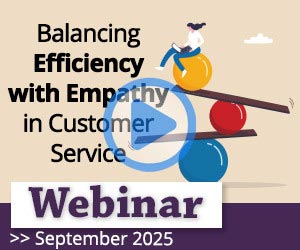We investigate some simple training messages and techniques that will enable your contact centre agents to show genuine interest in your customers.
Beware of Jumping to Conclusions
Sometimes, a key message to give advisors is to: Move away from the solution and focus on the customer.
An advisor’s expertise can often send them down the wrong track, especially if they take on a closed-mind approach of: “I’ve had this query before, this is the answer.”
Your team should realize that it is not always that cut-and-dry. So actively encourage advisors to stay curious and not jump to conclusions.

“The more interest you demonstrate in the customer, the more curious you are and the more questions you ask, the better the outcome that you can provide for that individual customer. That is the key,” says Gavin Scott, Managing Director at Loaf Training.
An Interesting Statistic
It’s part of our DNA as human beings to be inquisitive. In fact, the average four-year-old asks up to 300 questions a day, according to The Telegraph.
Children ask all these questions for the simple reason that they want to know the answers. We can take a similar inquisitive approach with customers. It is, after all, within our human nature.
This can be a good message to share with the team. Why? Because it is important for advisors to consider that showing interest and being curious is what will really allow them to connect with each customer.
Your team leaders will ideally remind your advisors, in conversations every now and then, that the person who they are about to speak to is a real person with both functional and emotional needs. Don’t let them become just another call.
For more important conversations like this to have with your team, read our article: 10 Great Conversations to Have With Your Contact Centre Team
Interest Is a Two Way Street
To show interest, advisors can ask more questions and pick up on the small details about the customer’s life that they share on the call.
Advisors will likely also realize another benefit that the more interest they show in the customer, the more interest the customer will have in them.
When you ask questions and encourage someone to do most of the talking, they naturally become more interested in what you have to say. This is as true in general life as it is in the contact centre.
Not only this, but the customer will – over the course of the call – listen more to the responses that the advisor gives.
However, much of the skill in showing interest revolves around asking the right questions.
Ask Open and Not Closed Questions
To show genuine interest in the customer, you want to ask them open questions. This enables them to take the leading role within the conversation.
Open questions are questions in which the customer cannot reply with a simple yes or no. They require a more detailed response.
In the moment, it can be hard for advisors to change their line of questioning, so a good technique to train them to use to ensure they are asking open questions is TED questions.
TED stands for:
- Tell
- Describe
- Explain
By adding any of these words to the beginning of a question, the advisor can open up the conversation.
Consider how your team can rephrase typical closed questions that are asked in your contact centre, using the TED principle, as we have done in the table below.
| Closed Questions | TED Questions |
|---|---|
| Are you happy with our service? | Tell me how you feel about our service |
| Did you enjoy the experience? | Explain to me what you enjoyed about the experience |
| Does it look different to how it was described | Describe how it looks… |
Using these TED questions to show interest in the customer can also be helpful in enabling you to change the mindset of a customer or better understand them.
Put Your Open Questions Through the Funnel
Once you have asked open questions, it is great to follow up with a probing question to delve deeper into the customer’s response.
Examples of probing questions include:
- What was the result when you tried to…?
- What were you doing when the problem began?
- What does it look or sound like? (“Can you” is a closed question)
Then the advisor can bring in their closed questions to confirm both their and the customer’s understanding of what is being discussed..
This three-step process, as again highlighted below, is known as “The Funnel Effect”:
- Ask an open question
- Ask a probing question
- Ask a closed question
This approach can be great to teach advisors, as it allows them to demonstrate interest in the customer’s issue – through open questions and probing – while methodically solving their problem.
Useful techniques like this can be taught in induction training and topped up with coaching.
Kristin, one of our readers, adds: “We include listening and questioning skills during induction then top this up as required with ‘kit box’ exercises.”
For more great questioning techniques like these, read our article: 10 Effective Questioning and Probing Techniques for Customer Service
Don’t Make It All About You
In fact, in Dale Carnegie’s book, “How to Win Friends and Influence People”, he says the most commonly used word on the phone is “I”.
Yet we need to train advisors to refrain from talking about themselves, to instead focus on listening to the customer.
What Three Things Do You Know About This Customer?
To help make this point in her contact centre, Stephanie, one of our readers, runs the following exercise: “In coaching, when reviewing a customer’s call, ask your advisor: what three things do you know about this customer?”
Running exercises like this is important because when a customer feels as though they are not being listened to, that causes frustration. They become less open to the advisor’s solutions and recommendations.
However, if the advisor can create the space for customers to talk about themselves, that will really benefit the conversation, as the customer is no different from the rest of us. They will most likely enjoy talking about themselves too!
If the advisor can really listen and engage with the customer’s responses – picking up on the key details in what is said (and often what is not) – rapport levels will skyrocket.
These snippets of information are what Gavin Scott refers to as the “Gold Dust”, and we can then use this “Gold Dust” to end the interaction on a high and really demonstrate how interested you were when interacting with your customer:
For example: “Thanks for your time today, it’s been great speaking to you. I hope your son has an enjoyable birthday party at the weekend!”
For more on listening well in the contact centre, read our article: How to Train Active Listening in the Contact Centre – With Four Exercises
A Fun Exercise for Showing Interest
When training advisors to show interest in the contact centre, Gavin runs an exercise that he has named: “Why do I have a headache?”. It’s an exercise that he first came across when he was an associate with a previous training provider.
This exercise is a great way to show advisors the value of asking open questions over closed questions as a method of demonstrating curiosity.
Step 1: In the workshop – or alternatively on a video call – start by saying:
“Hey guys, I wonder if you can help me. I’ve got a bit of a situation. I’m suffering from headaches and these headaches occur in the morning.
What I’d like you to do is be my doctor, and I’ll be completely candid and open with you, but I’d like it if you could ask me some questions to try and diagnose what the problem might be.”
The responses that advisors give will likely centre around what the solution might be. For example:
- Are your drinking enough water?
- Have you had your eyes tested recently?
- Are you feeling stressed?
- Are you enjoying your work?
All of these questions are closed questions. So just answer: “Yes. No. No. Yes.”
Step 2: After about 10–15 questions, stop and ask the team: “Are you any closer to working out what the issue might be?”
Usually, this question is answered with a chorus of noes. So tell the team:
“What you’re doing is focusing on your own solution rather than focusing on me. You’re making assumptions based on your experiences as to what the solution might be and you’re throwing that at me.”
“What do you know about my headaches? I’ve told you they’re happening in the morning, so delve a bit deeper.”
What happens is that eventually someone asks a question along the lines of: “Talk me through your morning routine.”
Just from this one open question, advisors learn more useful information than they had done previously through asking lots of closed questions.
What Did the Exercise Show Us?
This exercise shows the value of demonstrating a level of curiosity, rather than being too quick to give people answers.
Once the team started to ask Gavin about his routine, they could focus on the right solution for him, instead of assuming their own solutions.
As the trainer you can use this example to share other examples of good questions they could have asked – using TED questions to showcase how valuable they can be.
Ask the team to only use their closed questions once they have got to the heart of the issue, as these will help advisors to focus on the right solutions.
Find more great customer service training exercises like this by reading our article: 16 Customer Service Training Ideas – With Activities, Games and Helpful Techniques
To find out more advice for how to improve rapport in customer service, read our articles:
- Rapport Building With Angry Customers – With Examples
- 27 Effective Ways to Build Customer Rapport
- 50 Great Complimentary Words to Use in Customer Service
Author: Robyn Coppell
Reviewed by: Hannah Swankie
Published On: 31st Mar 2021 - Last modified: 30th Sep 2025
Read more about - Customer Service Strategy, Call Handling, Customer Engagement, Editor's Picks, Gavin Scott, Service Strategy, Soft Skills

















